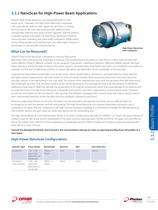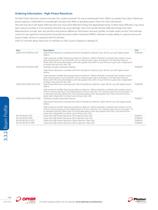
Catalog excerpts

3.3.2 NanoScan for High-Power Beam Applications Photon’s High-Power NanoScan can measure focused CO2 laser beams up to 5 kilowatts. The High-Power NanoScan is equipped with a pyroelectric detector with copper slits and drum. A cooling fan mounted on the scan head body provides additional heat management. With the new “peak connect” algorithm and the software controlled variable scan speed, the High-Power NanoScan is ideal for measuring lasers operating with pulse width modulation (PWM) power control. Measurement of Q-switched lasers and other higher frequency pulsed lasers is also possible using this feature. High-Power NanoScan with cooling fan What Can be Measured? Photon’s High-Power NanoScan is designed to measure “high-power” laser beams that were previously impossible to measure with standard NanoScan products. High-Power is a fairly indistinct term that means different things in different contexts. For our purposes, “high-power” is defined as between 100W and 5000W, however the HighPower NanoScan will not be able to measure this power range for all wavelengths. High-Power laser beams are handled by using reflective materials, and the level of reflectivity, and thus its inverse, absorption, are dependent on the wavelength of the laser light. Measuring high-power beams can be tricky. The lasers have the potential to damage the scan head, and any reflected light can be dangerous to both the operator and the surroundings. The High-Power NanoScan can measure these beams because it uses a combination of highly reflective components with high thermal dissipation capability. It is important to manage the reflected beam so that it neither reenters the laser cavity nor sends stray beams into the surrounding area. The High-Power NanoScan scan head has been shown to be able to handle power densities of 3.2MWcm-² at 10.6μm, the power density of a 200μm beam at 1kW. At the shorter wavelengths of the other common industrial lasers, Nd:YAG and DPSS, the upper limits are little less, due to the slightly lower reflection of the components at wavelengths around 1000nm. Visible and UV lasers can also be measured, but these will have lower limits yet. Consult the damage thresholds charts found in the manual before placing an order or exposing any NanoScan slit profiler to a laser beam. High-Power NanoScan Configurations Detector Type Power Range Wavelength Aperture Slits Scan Head Size Pyroelectric ~1W - ~5W upper limit dependent on wevelength ~1W - ~5W upper limit dependent on wevelength 190nm - > 100μm 9mm 5μm 100mm 190nm - > 100μm 20mm 10μm 3.3.2 Beam Profile In general the long infrared wavelengths, such as that of the carbon dioxide laser at 10.6microns, are highly reflective. These allow for the highest power measurements up to the maximum levels of several kilowatts. When measuring these lasers and power levels the principle concern is the heat buildup in the scan head. The surfaces of the measurement drum and slits are better than 98% reflective to this wavelength, and thus only 2% of the incident power will be absorbed by the scanhead and heat it up. Nonetheless, at 5000W this represents a heat load of 100W that will raise the temperature of the internal components, which may cause damage to the detector and encoder electronics. The High-Power NanoScan is designed to be used for short-term measurements at these power levels. The beam should only be incident on the scan head for a few seconds. The software is equipped with a record mode that makes it easy to make a short measurement and then review the data while the scanhead is allowed to cool down. 100mm Pyroelectric Large Aperture 159 For latest updates please visit our website: www.ophiropt.com/photonics 12.07.2012
Open the catalog to page 1
Ordering Information - High-Power NanoScan All High-Power NanoScan Systems Include: Fan cooled scanhead. For use at wavelengths from 200nm to greater than 20μm. Maximum power capacity is dependent on wavelength and spot size. Refer to operating space charts for more information. Slits and scan drum are highly reflective and user must send reflected energy into appropriate dump. A direct back reflection may cause laser cavity to oscillate or if not properly directed may cause damage. User must handle all back-reflected energy from laser. Measurements include: spot size, position and position...
Open the catalog to page 2All Ophir Optronics catalogs and technical brochures
-
SP932U
1 Pages
-
ConoPoint-3
2 Pages
-
nova catalog
2 Pages
-
nova ii catalog
2 Pages
-
vega catalog
2 Pages
-
BeamWatchAM
2 Pages
-
StarBright
2 Pages
-
680274
1 Pages
-
P920 Beam Profiling Camera
1 Pages
-
L2000W-PF-120
1 Pages
-
L40(250)A-BB-50
1 Pages
-
IS1.5-VIS-FPD-800
1 Pages
-
Optimet Industrial Catalog 2017
34 Pages
-
Energy Sensors Accessories
1 Pages
-
StarLite
2 Pages
-
Power Meters & Interfaces
1 Pages
-
Power Meters Vega
2 Pages
-
Goniometric Radiometers
3 Pages
-
1780 Instantly measure M 2
2 Pages
-
M200s
3 Pages
-
NanoScan 2s
14 Pages
-
LBS-100 Attenuato
1 Pages
-
LBS-400 Beam Splitters
1 Pages
-
maging UV lasers
1 Pages
-
Near Field Profilers
1 Pages
-
BeamWatch®
5 Pages
-
ModeCheck ®
3 Pages
-
Nova
2 Pages
-
Calorimetric Power Meter
1 Pages
-
Power Pucks
1 Pages
-
High Power Thermal Sensors
1 Pages
-
Thermal Power Sensors
1 Pages
-
ompact Juno USB Interface
7 Pages
-
StarBrigh
2 Pages
-
Standard Photodiode Sensors
3 Pages
-
Medium Power BeamTrack-Power
1 Pages
-
Low Power BeamTrack-Power /
1 Pages
-
YAG Focal Spot Analyzer
2 Pages
-
Standard OEM Thermal Sensors
1 Pages
-
PC Interfaces Juno
5 Pages
-
Photodiode Energy Sensors
5 Pages
-
Pyroelectric Energy Sensors
1 Pages
-
Orion
2 Pages
-
Laserstar
2 Pages
-
RP Sensors
2 Pages
-
Pyroelectric Energy Sensors
1 Pages
-
Special Photodiode Sensors
1 Pages
Archived catalogs
-
Laser Beam Profile Catalog
42 Pages
-
Laser Beam Prifile catalog
42 Pages
-
Complete Catalogue OPHIR
155 Pages
-
Laser Beam Profile
42 Pages
-
Laser Power Meters
4 Pages


























































































